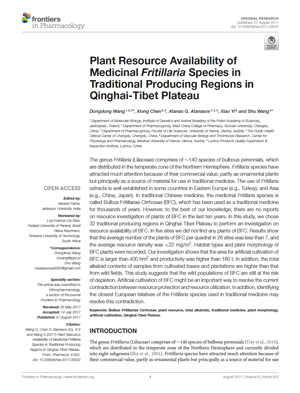NEWS 2017
Plant Resource Availability of Medicinal Fritillaria Species in Traditional Producing Regions in Qinghai-Tibet Plateau
Dongdong WANG¹,²,³, Xiong CHEN²,⁴, Atanas G. ATANASOV¹,³,⁵, Xiao Yi⁶, Shu WANG²
Frontiers Pharmacology (2017)
doi.org/10.3389/fphar.2017.00502
¹Department of Molecular Biology, Institute of Genetics and Animal Breeding of the Polish Academy of Sciences, Jastrzębiec, Poland
²Department of Pharmacognosy, West China College of Pharmacy, Sichuan University, Chengdu, China
³Department of Pharmacognosy, Faculty of Life Sciences, University of Vienna, Vienna, Austria
⁴The Public Health Clinical Center of Chengdu, Chengdu, China
⁵Department of Vascular Biology and Thrombosis Research, Center for Physiology and Pharmacology, Medical University of Vienna, Vienna, Austria
⁶Luzhou Products Quality Supervision & Inspection Institute, Luzhou, China
Abstract
The genus Fritillaria (Liliaceae) comprises of ~140 species of bulbous perennials, which are distributed in the temperate zone of the Northern Hemisphere. Fritillaria species have attracted much attention because of their commercial value, partly as ornamental plants but principally as a source of material for use in traditional medicine. The use of Fritillaria extracts is well established in some countries in Eastern Europe (e.g., Turkey), and Asia (e.g., China, Japan). In traditional Chinese medicine, the medicinal Fritillaria species is called Bulbus Fritillariae Cirrhosae (BFC), which has been used as a traditional medicine for thousands of years. However, to the best of our knowledge, there are no reports on resource investigation of plants of BFC in the last ten years. In this study, we chose 32 traditional producing regions in Qinghai-Tibet Plateau to perform an investigation on resource availability of BFC. In five sites we did not find any plants of BFC. Results show that the average number of the plants of BFC per quadrat in 26 sites was less than 7, and the average resource density was less than 22 mg/m2. Habitat types and plant morphology of BFC plants were recorded. Our investigation shows that the area for artificial cultivation of BFC is larger than 400 hm2 and productivity was higher than 180 t. In addition, the total alkaloid contents of samples from cultivated bases and plantations are higher than that from wild fields. This study suggests that the wild populations of BFC are still at the risk of depletion. Artificial cultivation of BFC might be an important way to resolve the current contradiction between resource protection and resource utilization. In addition, identifying the closest European relatives of the Fritillaria species used in traditional medicine may resolve this contradiction.




